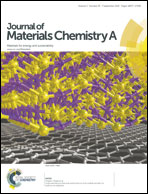Facile and scalable fabrication of three-dimensional Cu(OH)2 nanoporous nanorods for solid-state supercapacitors†
Abstract
A facile and scalable one-step anodization method has been developed to fabricate three-dimensional (3-D) Cu(OH)2 nanoporous nanorods on a copper foil substrate, a product that can be used directly as a binder-free electrode for supercapacitors. The unique morphology of the nanorods provides a large amount of active sites for redox reactions, which can be easily accessed by electrolyte ions. Benefiting from that, a high capacitance of 213 mF cm−2 is obtained, and superior rate capability (62.3% capacitance retention when the scan rate is increased to 10 times) and excellent cyclability (92.0% capacitance retention after 5000 cycles) are achieved. In addition, a flexible and foldable solid-state asymmetric supercapacitor is assembled using the Cu(OH)2 and activated carbon as the positive and negative electrodes, respectively. The devices deliver a high energy density of 3.68 mW h cm−3 and a high power density of 5314 mW cm−3, demonstrating great potential for next-generation high-rate energy storage systems.


 Please wait while we load your content...
Please wait while we load your content...